
Illustration by The Sprawl. Photos: Leah Hennel, Hans Veth
Undermined: Canmore’s struggle to curb sprawl
For wildlife, the Bow Valley is on the brink.
Sprawlcast is Calgary’s in-depth municipal podcast. Made in collaboration with CJSW 90.9 FM, it’s a show for curious Calgarians who want more than the daily news grind.
This Sprawlcast is a collaboration with The Narwhal, an independent news outlet that dives deep to tell stories about the natural world in Canada. Drew Anderson contributed reporting and research for this story. You can read his article on the Three Sisters saga here.
This is the second episode in a Sprawlcast series. The first episode, on Canmore's coal mining history and the origins of the Three Sisters project, is here.
If you value in-depth Calgary journalism, support The Sprawl so we can do more stories like this one!
SARA RENNER: I think we feel like we’ve been let down by the democratic process.
COUNCILLOR JEFF MAH: Our provincial government's framework has failed us.
CHRIS OLLENBERGER: Unfortunately, a lot of people for a number of years had assumed that the town could always just say no whenever they wanted to.
COUNCILLOR WADE GRAHAM: If we never had a choice, then why was this document ever even brought before council? Are we just a rubber stamp?
JEREMY KLASZUS (HOST): Picture this. It’s a sleepy October Sunday in Calgary. And about 20 people from Canmore are gathered in the swanky southwest neighbourhood of Mount Royal. They’re across the street from the mansion of Don Taylor, the Calgary businessman and philanthropist.
Don and his son David are the majority shareholders of Three Sisters Mountain Village Properties. And Three Sisters is planning to build two new projects in Canmore that will nearly double the town’s population in the coming decades.
The controversy over these developments has been simmering in Canmore for decades but on this particular morning, it’s boiled over to Calgary, almost to Don Taylor’s doorstep.
And I asked these protesters: Why are you here?
KARSTEN HEUER: We’re talking about the last functional wildlife corridor linking Banff National Park to Kananaskis Country.
ZAC MILLS: We are here because we are launching a campaign to save Grizz Corridor, and we’re calling upon Danielle Smith and the UCP to buy these lands.
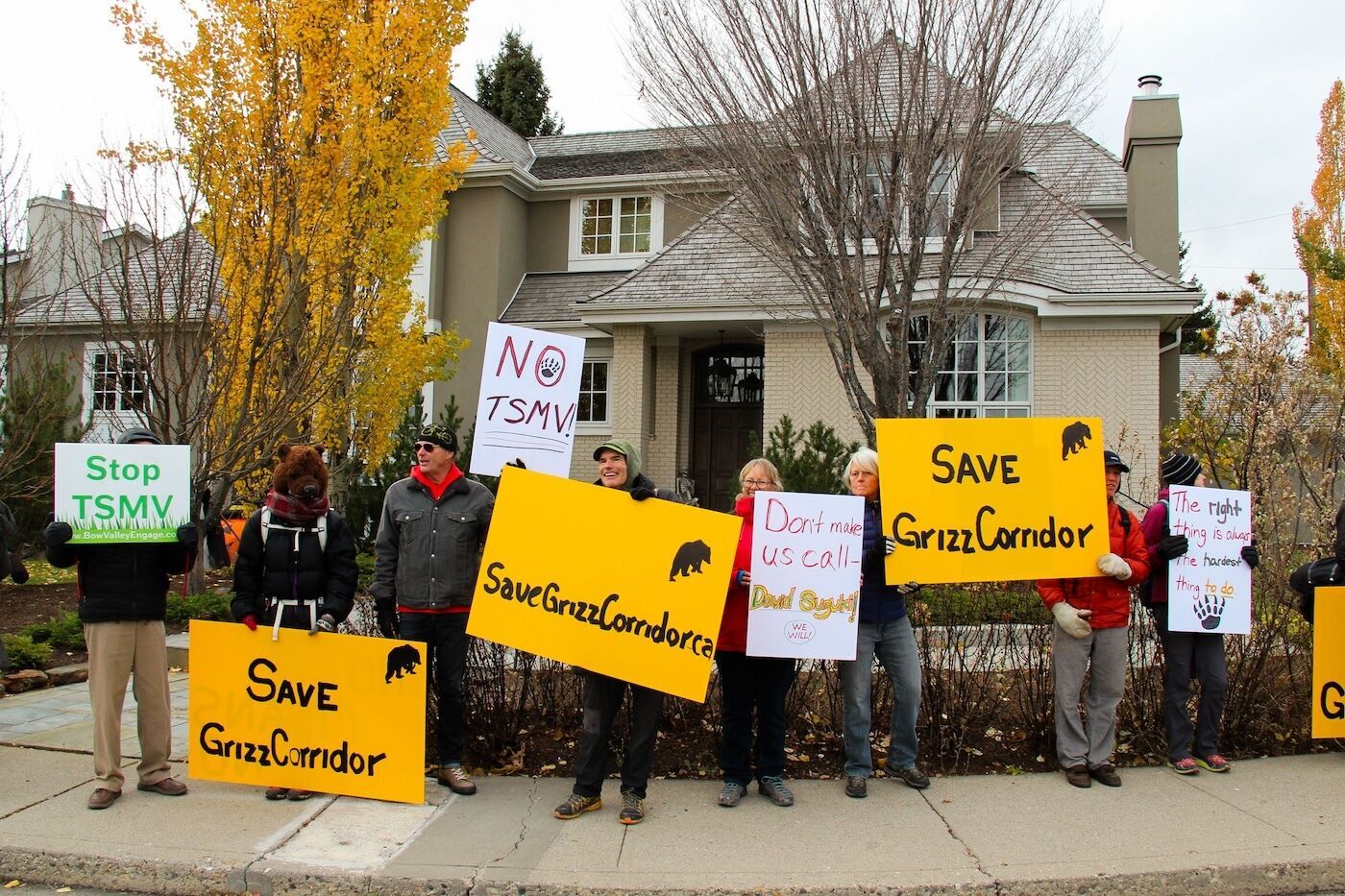
KLASZUS: The protesters weren’t the only ones who showed up that afternoon.
MILLS: There are five police cars here for this very peaceful vigil.
KLASZUS: Yeah, I was a little surprised to see so many cops here.
MILLS: We come here in peace.

KLASZUS: This was pretty much what you would expect a Canmore protest to be. People quietly held signs and I interviewed one person in a bear costume who did the interview in character, as a grizzly bear.
KLASZUS (TO PROTESTER): What do you think is at stake for you and your kind if this development proceeds?
GRIZZLY BEAR: What’s at stake is our ability to find food and habitat and mates. So I need to be able to roam around my full territory. And it’s really hard to do that when I try to walk through the valley but there are houses everywhere. And I can’t walk through their yards because they get mad at me. They chase me out of town. There are all these distractions around like garbage cans that smell so good!
And I kind of wander off my path and forget that I was on a mission to walk through this valley and go through the corridor. But the majority shareholders who live here in this house, they’re going to take that corridor away.
KLASZUS: Well, thanks very much. I didn't ask you your name at the start of this.
GRIZZLY BEAR: My name? I'm a grizzly bear! [laughter]

We’re talking about the last functional wildlife corridor linking Banff National Park to Kananaskis Country.
KLASZUS: Before we continue, let’s do a very brief recap of the previous Sprawlcast episode. The main thing to keep in mind is that in 1992, a newly-created provincial tribunal called the Natural Resources Conservation Board, or NRCB, approved a “recreational and tourism project” for Canmore.
Here’s Calgary developer Chris Ollenberger. His company, QuantumPlace Developments, is managing the Three Sisters project.
CHRIS OLLENBERGER: It was deemed to be a project in the interest of the province. And so it has an order-in-council approval from cabinet that says this project will proceed.
The Bow Valley: A constantly-changing landscape
KLASZUS: To get the long view of the situation in Canmore today, I met up with Leanne Allison and Tracey Henderson. They’re part of a citizen group called Bow Valley Engage, which has been opposing the Three Sisters plans. Bow Valley Engage organized the Calgary protest we just heard. And on a rainy December day, we hiked up toward the Alpine Club in order to get a decent view of the town and valley and see how Canmore has grown over the years.
On the way up, Allison, who’s a documentary filmmaker, told me a little more about what it’s like to live in the Bow Valley. And she emphasized how living with wildlife is a big part of the town’s cultural identity.

LEANNE ALLISON: We’re proud of coexisting with things like grizzly bears and wolves, and we’ve actually developed ways of doing that that are being shared around the world.
KLASZUS: A few years ago, Allison made a short film about exactly this. It’s called “Living With Wildlife.” The opening lines of the film are from Jay Honeyman. He retired in 2022, but at the time he was a human-wildlife conflict biologist for the Alberta government.
JAY HONEYMAN (FROM “LIVING WITH WILDLIFE” FILM): I think one of the biggest challenges in the valley—and it’s been going on for over 20 years now, it’s been going on since the mid-'80s—is the constant change of the landscape itself within the Bow Valley.
Everybody’s having to learn new things every single year, and that includes animals and how they move through the valley.
An example of that would be many years ago following a radio-collared grizzly bear into the Bow Valley here. And I remember sitting at a corner waiting for her to pop out to try to keep her from entering into a development. And I remember her popping out onto the edge of the forest, and going up on her hind legs, and looking around—and what used to be a forest the previous fall was now completely gone and was just a big construction zone. And I just looked at her, and it was like she was thinking, oh my gosh, what happened, and what do I do now?
What used to be a forest the previous fall was now completely gone and was just a big construction zone.
KLASZUS: Tracey Henderson is a local veterinarian who used to run an organization called the Grizzly Bear Alliance. And as we hiked, she talked about the plight of grizzly bears, a threatened species in Alberta.
TRACEY HENDERSON: We are what I used to call the eastern extinction front of the grizzly bears.
KLASZUS: Before the colonization of the West, grizzly bears roamed the prairies and as far south as Mexico.
HENDERSON: But over time, they've been pushed northward and westward. And we are now that front—the Eastern Slopes of the Rockies.
KLASZUS: Once we’d hiked up for about 20 minutes, we could look down and see the town of Canmore sprawled out below us. The Three Sisters lands are on the south side of the Trans-Canada Highway, but as Henderson pointed out, the town has grown significantly on the north side in recent decades.
HENDERSON: When they were making a judgment call on the impacts of those lands, none of this existed on this side of the valley. So they were looking at a big, open valley. And now, in 2023, it’s a whole different story.
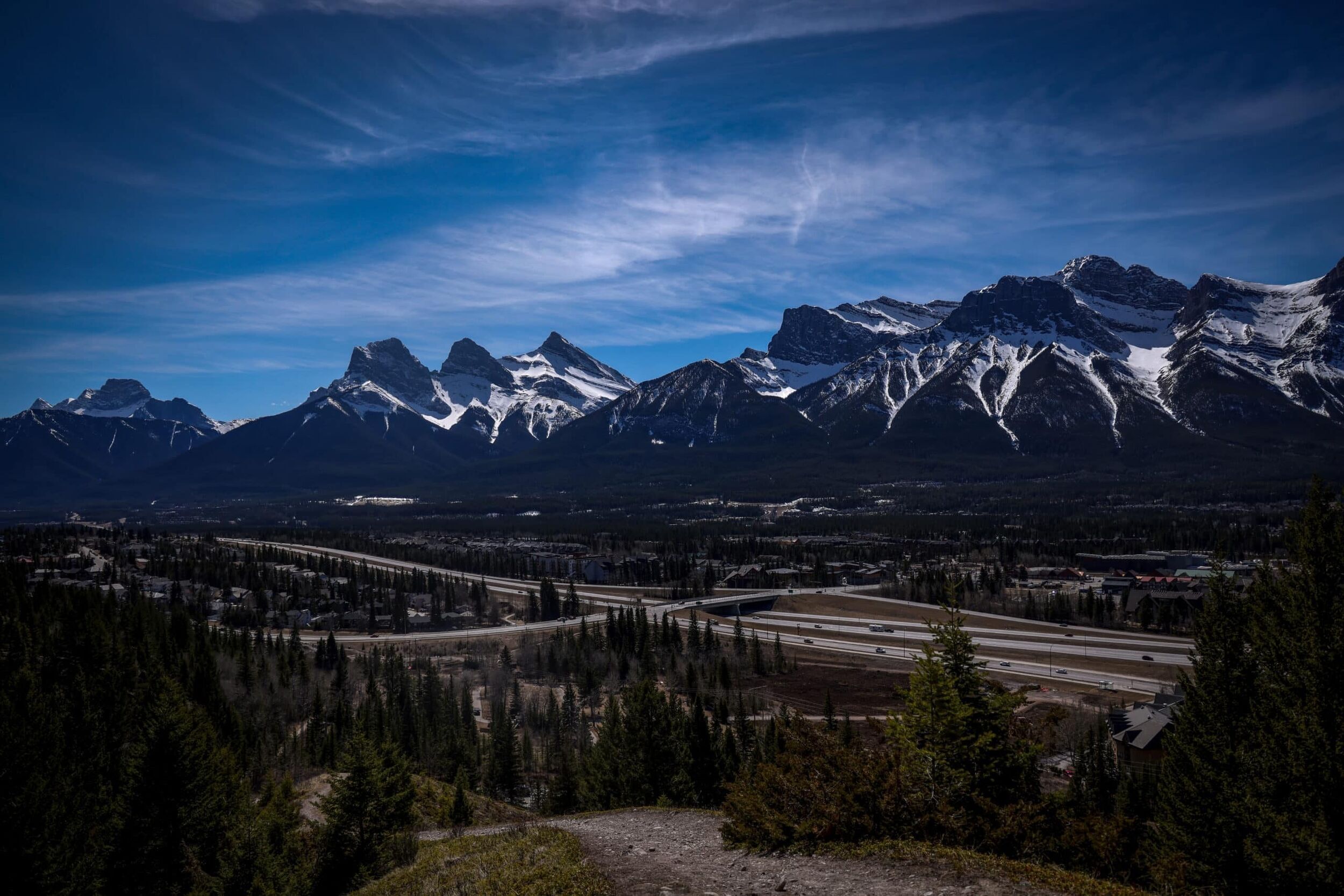
KLASZUS: From up high, we could see the long stretch of the Three Sisters lands extending eastward from the town. This is land that previously belonged to the Canmore Mines, which shut down in 1979.
Picture this long stretch of land divided into three sections. The middle is already built out with housing subdivisions and the Stewart Creek golf course. The future neighbourhoods in dispute are on either side of this existing development. On the east side, Three Sisters wants to build a low-density neighbourhood called Smith Creek. The west side is slated for a more compact development.
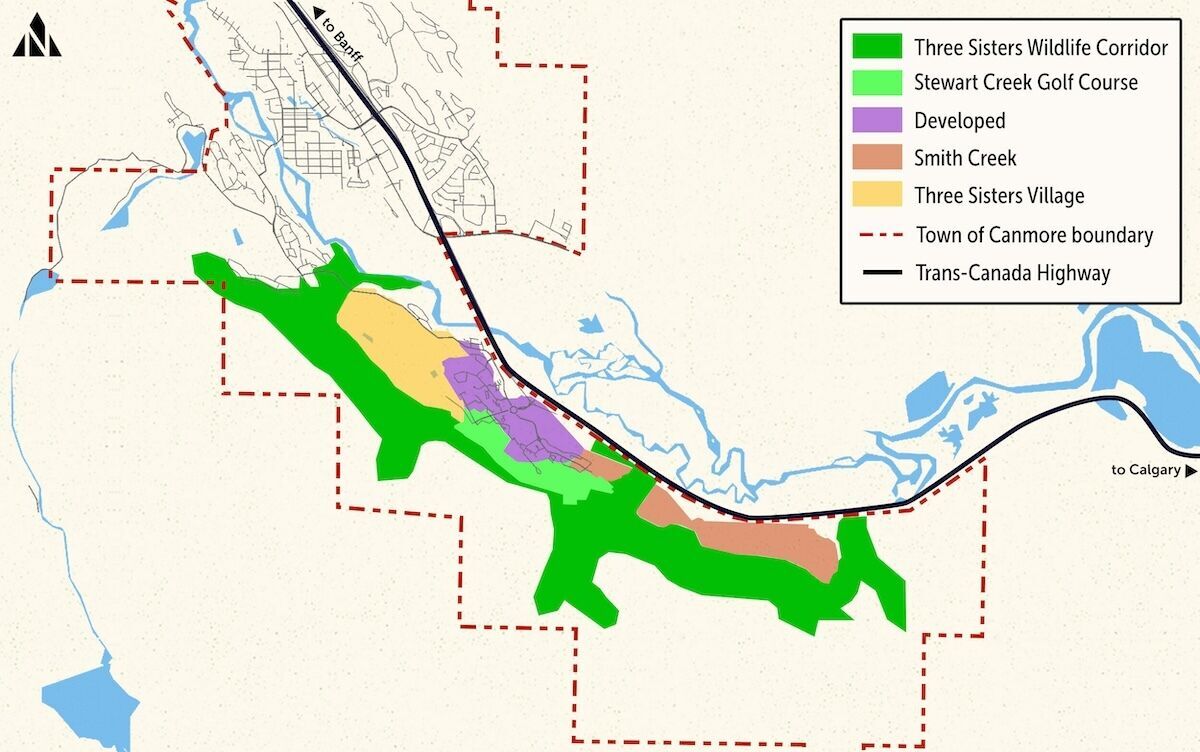
ALLISON: That right there is the unfinished golf course.
KLASZUS: It doesn’t look like much today. But when town council approved the Three Sisters Resort Centre plans twenty years ago, in 2004, this golf course was a crucial component. The idea at the time was that the Resort Centre project would be a health and wellness resort with this golf course alongside.
HENDERSON: It was agreed that even though it was a golf course—or was planned to be a working golf course—it was still good wildlife habitat. There was still a role for it, particularly in the off-seasons.
KLASZUS: The golf course was seen as a solution to a few problems. It was a light use on some of the most heavily undermined Three Sisters lands. There are old coal mine workings under the surface. And the golf course could help salvage the wildlife corridor that had been rushed through in the late ’90s. Here’s retired provincial wildlife biologist Jon Jorgenson.
JORGENSON: Even though there’s the acknowledgement that some of that corridor was probably not the best, we felt that because we had the golf course there, that golf course was going to provide a buffer between the designated wildlife corridor and any development that got built.
KLASZUS: Even that was controversial at the time. There were local campaigns to block construction of the golf course. “Say NO to golf development in wildlife corridors!” read one flyer from 2001.
Even though it was a golf course… it was still good wildlife habitat. There was still a role for it, particularly in the off-seasons.
KLASZUS: But only 15 holes of the golf course ever got built. Work stopped around 2009, when Three Sisters filed for bankruptcy.
That’s the other thing to remember about this project: It has changed hands numerous times over the years. Current co-owners Don Taylor and former Morgan Stanley executive Blair Richardson entered the scene in 1999, when a company called TGS Properties bought the land. It morphed from there, with Morgan Stanley buying the project in 2007. But then came the recession of 2008. Work on the golf course stopped. Three Sisters declared bankruptcy, and the golf course has sat there unfinished since.
Fast forward a few years. Blair Richardson, Don Taylor and his son David re-purchased the beleaguered project in 2013. And in 2017, Three Sisters went before town council with a new plan for the Resort Centre development. Here’s town planner Tracy Woitenko presenting the plan to council.
TRACY WOITENKO: I’m just going to give a brief background of what’s proposed to change in the area structure plan amendment. So the biggest thing is the elimination of the golf course.

To build another golf course wouldn’t be economically viable, Three Sisters argued.
KLASZUS: Before this meeting, Three Sisters had made its case to the town, saying golf was declining in popularity. And on top of that—there were already plenty of golf courses in the Bow Valley. The market was oversaturated. To build another golf course wouldn’t be economically viable, the company argued.
Three Sisters Golf Resorts was the company that originally got provincial approval from the NRCB in 1992. That project was going to have four golf courses, along with six hotel complexes and some residential development. But now, 25 years later and under different ownership, Three Sisters was ditching golf.
Now the company wanted to build housing and resort accommodation on the golf course. This did not go over well with council. Let’s listen in to that 2017 meeting.
MAYOR JOHN BORROWMAN: The 2004 area structure plan that was previously approved, that’s in effect right now, gave very clear direction, I thought, for the vision that reflected the intent of the NRCB decision report which would bring benefit to our community. There’s a substantial change of use proposed for the golf course area in the Resort Centre ASP. And I’m not of the opinion that such a dramatic change is beneficial to the community at this time.
COUNCILLOR JOANNA McCALLUM: I think that this ASP, much like the mayor has stated, is fine the way it is.
COUNCILLOR ESMÉ COMFORT: It's too much of a change from golf course to housing and resort accommodation.
COUNCILLOR VI SANDFORD: I was looking for a resort centre, and what I feel that we’re being proposed here is another town centre. It’s a town with a bunch of services to facilitate the people living there.
KLASZUS: Here’s Sean Krausert, who is Canmore’s mayor today but was a councillor at the time.
COUNCILLOR SEAN KRAUSERT: I simply have no particular appetite for the level of development on the undeveloped golf course as is proposed. I do not think that that's in the best interest of the community.
KLASZUS: Council unanimously voted no.
It’s too much of a change from golf course to housing and resort accommodation.
The UCP reverses course on wildlife corridor
KLASZUS: That same year, in 2017, Three Sisters applied to the province to establish a wildlife corridor for Smith Creek. This is the other development the company was hoping to build—the easternmost one, across from Dead Man’s Flats.
When the Natural Resources Conservation Board, or NRCB, approved the project in 1992, it required Three Sisters to map out wildlife corridors on its property and get them approved by the province before building. And this Smith Creek corridor was the last piece of the wildlife corridor puzzle for Three Sisters.
The Taylors and Blair Richardson had a keen interest in getting this done—even when they didn’t own the property. In 2012, the court-appointed receiver for the project noted that Don Taylor and Richardson were working on the corridor issue themselves as creditors in the Three Sisters bankruptcy. They brought proposals to town council while the receiver kept the province up to speed. And they kept at it after they re-purchased the property in 2013.
But in 2018, the Alberta government rejected Three Sisters’ proposed Smith Creek wildlife corridor because of concerns that it was too narrow in two locations.
In 2020, the UCP government changed course with an announcement that shocked local scientists, town councillors and citizens.
TARA NELSON (CTV CALGARY): A controversial decision from the province to approve a wildlife corridor design nearly two years after it was first rejected by the NDP. Now the developer says it means work can finally go forward.
KLASZUS: Here’s what David Taylor of Three Sisters told CTV at the time.
DAVID TAYLOR: We massaged the data from the 2018 decision that was put out by the province to meet their two needs. Longtime coming. We're happy with this.
KLASZUS: The Yellowstone to Yukon (Y2Y) Conservation Initiative said that although the corridor was widened in those two spots, it was still too narrow elsewhere and that the decision had been “made in secret.” Here’s what Y2Y conservation director Hilary Young told CTV in 2020.
HILARY YOUNG: We feel like it’s a political decision. We feel like it is not reflecting current, up-to-date wildlife science.
We massaged the data from the 2018 decision that was put out by the province to meet their two needs.
KLASZUS: Three Sisters now had a wildlife corridor that ran the length of the lands. Rather than leaving a little more breathing room for wildlife with “soft” and permeable areas like the golf course, the province now required “habitat enhancements” for wildlife in narrow spots. Here’s Rick Blackwood, assistant deputy minister for environment and parks, speaking to town council in 2020 right after the province approved the Smith Creek corridor.
RICK BLACKWOOD: We will look at places within the corridor, and probably most likely in areas where the corridor narrows, to try to see if there are ways that we can alter the vegetation or augment what is there in a way to help attract wildlife and help them to move through the corridor.
KLASZUS: Here’s Chris Ollenberger, director of strategy and development for Three Sisters, at that same council meeting.
OLLENBERGER: The previous concept that sometimes encouraged conservation easement buffers, like exists around the 2004 Resort Centre area structure plan—that type of extra layering is no longer required because of the decision today.
We feel like it’s a political decision. We feel like it is not reflecting current, up-to-date wildlife science.
KLASZUS: By this time, Three Sisters was also proposing to build wildlife fences around the new developments. Ollenberger says it will be fencing similar to what you see along the highway in Banff National Park. The province also plans to build fencing like that through Canmore along the Trans-Canada Highway starting in 2025.
OLLENBERGER: The number of incursions of elk wandering through the town and just hanging out by a garbage can or in somebody’s backyard—we’re going to cut that off. That’s going to be a big culture shift for Canmore.
KLASZUS: Ollenberger says layering buffer spaces like the golf course was tried but didn’t work.
OLLENBERGER: It didn't work because the humans, I think, didn't really respect the spaces that were identified to be used for wildlife. And it's a prolific problem throughout the entire Bow Valley.
KLASZUS: This has been a huge challenge in and around Canmore: managing the sheer numbers of people who are flooding not only designated trails, but also the wilderness around these areas. Not just people, but off leash dogs too. That’s with an existing town population of about 15,000 people. And Three Sisters is expected to nearly double that when it’s built out.
The humans, I think, didn’t really respect the spaces that were identified to be used for wildlife. And it’s a prolific problem throughout the entire Bow Valley.
KLASZUS: Here’s former provincial wildlife biologist Jon Jorgenson.
JORGENSON: You can have a really nice wildlife corridor. But if it's overrun by recreationists, it's not going to be very effective.
KLASZUS: Jorgenson says the approved Three Sisters wildlife corridors might be adequate...
JORGENSON: ...if the human use piece can be dealt with. But with the number of people that are living in the Bow Valley right now, and the number of people that are going to be living in the Bow Valley once Three Sisters is built out—oh man. There are people that I've worked with many, many years, and they just said: This is just never going to work.
Because the valley is finite. It is what it is. And all of the good wildlife habitat, and all of the good wildlife movement areas, have been built over, because they're basically in the valley bottoms.
And the corridors have been pushed up to the sides of the valley, up towards the steeper slopes. And you can only go so steep and there's no wildlife that's going to use those areas for movement.
All of the good wildlife habitat and all of the good wildlife movement areas have been built over.
An epic, weeklong public hearing on Three Sisters
KLASZUS: With its wildlife corridor approval in hand, Three Sisters came back to town council in 2021 with new plans for both developments. These areas made up about 80% of Canmore’s remaining developable land. Here’s Three Sisters owner David Taylor speaking to council.
DAVID TAYLOR: I have always said that I wanted to bring forward a proposal that is good for the community. If it’s good for the community, then it will be good for Three Sisters Mountain Village.
KLASZUS: The town had a few concerns. One was the split between residential and non-residential development. The town’s municipal development plan aspires to a split of 66% residential and 33% non-residential development when it comes to property assessments. These plans were more like 78% residential and 22% non-residential.
More commercial development means more tax revenue for the town. But housing is generally easier and faster and more profitable for developers to build. In 2021, the town said that over 98% of the assessed value on Three Sisters lands since 1992 has been residential, with some commercial projects approved twenty years prior only recently starting construction.
“Residential is dramatically outpacing commercial development,” the town later told the Land and Property Rights Tribunal, “and the proposed phasing starts with even more residential development.”
I have always said that I wanted to bring forward a proposal that is good for the community.
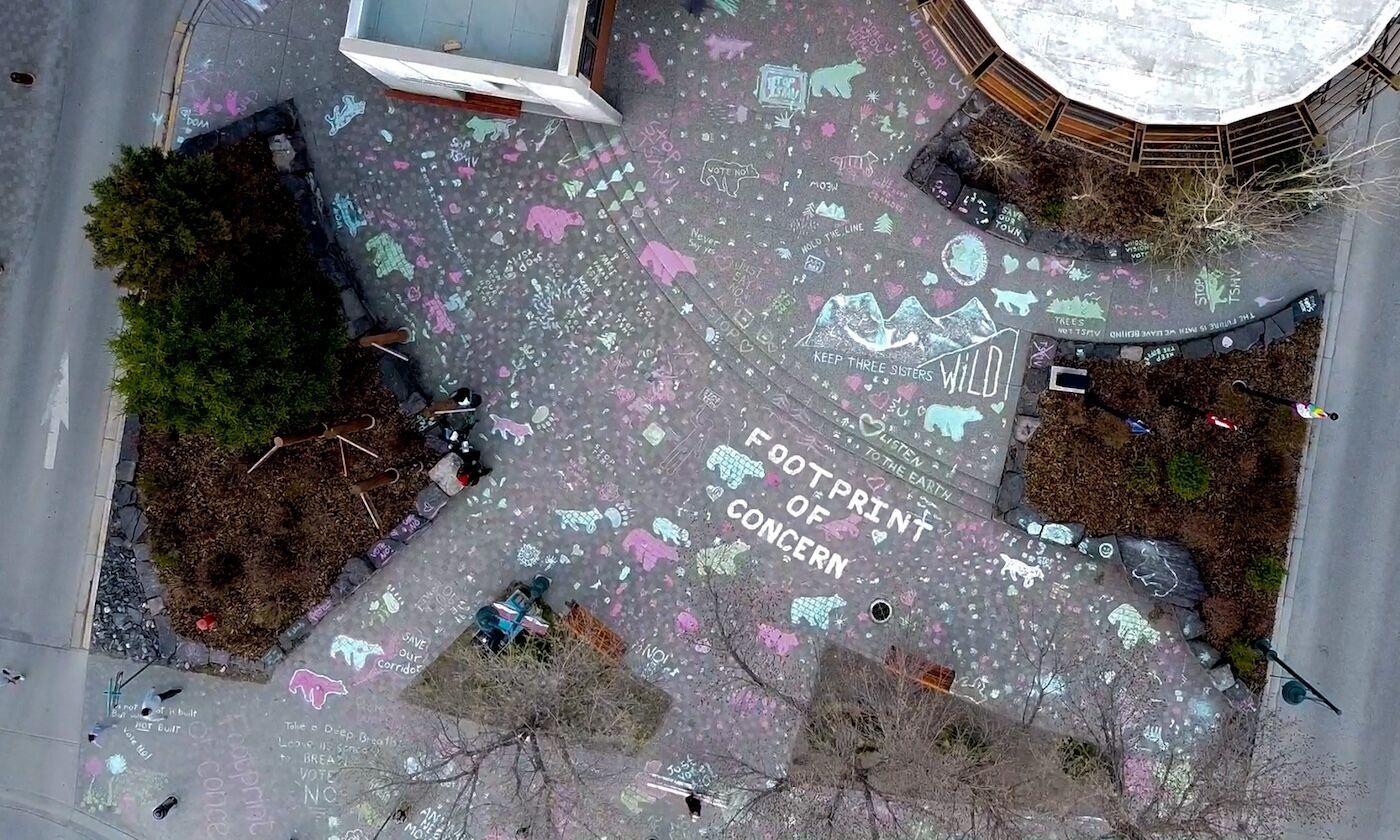
KLASZUS: In March of 2021, town council held an epic public hearing on Three Sisters’s proposed Area Structure Plans, or ASPs. It was a week of all-day hearings with more than 260 speakers, most of whom were opposed to the Three Sisters plans.
We’ll hear conservation biologist Sarah Elmeligi—this was before she became an MLA—along with William Snow of the Stoney Nakoda Nations, followed by Cori Brewster, Jane Whitney and Marlene Jones.
SARAH ELMELIGI: Even the potential of severing an internationally significant wildlife corridor is enough to reject these ASPs, in my professional opinion.
WILLIAM SNOW: Wildlife is an important part of the Stoney Nakoda history, spirituality, and culture.
CORI BREWSTER: Can we not always see land as what we can develop on it? What we can extract from it? How we can use it for our own benefit? To see it possibly as Indigenous people see it, important for the survival of all species. Can we stop our insatiable desire for more?
JANE WHITNEY: Empty homes do not promote the social fabric we voiced in our vision for Canmore.
MARLENE JONES: I don't want us to become like Aspen, Colorado.
The bylaw for the Three Sisters and Smith Creek applications should be denied.
KLASZUS: Of the 260-plus speakers, only nine listed themselves as in favour of Three Sisters’ plans. All nine were connected to the building industry in some way—homebuilders, other developers, consultants. We’ll hear homebuilder Tim Logel, engineer Chris Conner and real estate VP John Third.
TIM LOGEL: What I see in Canmore year after year after living there is that the demand for all types of housing is increasing. And recently, it’s dramatically increasing.
CHRIS CONNER: This proposal is not mindless sprawl to pad a developer’s pocket. It’s a careful and considered development proposal on an extremely complicated site.
JOHN THIRD: Don’t let NIMBYism stop our community from continuing to grow. We can’t allow those who are already here to close the door on those that wish to join and enrich our community.
Even the potential of severing an internationally significant wildlife corridor is enough to reject these ASPs, in my professional opinion.
KLASZUS: The last speaker of the public hearing was Three Sisters co-owner David Taylor.
DAVID TAYLOR: I will be honest that it has been difficult to listen over the past few days to so many people who have labeled us as greedy developers and portrayed us as speculators. And yet here I am feeling the need to defend myself, my family...
We’ve spent five years working to redefine these ASPs with input from the community after our previous ASP was not supported by council in 2017.
KLASZUS: Taylor said there was more support for Three Sisters than it seemed.
DAVID TAYLOR: I personally have heard from many locals who have said they support the plans, but were concerned about the backlash they could face if they stepped forward.
KLASZUS: Canmorites and Three Sisters had sent clear messages to town council about what they wanted. And now it was in the hands of council members to decide—or so they thought.
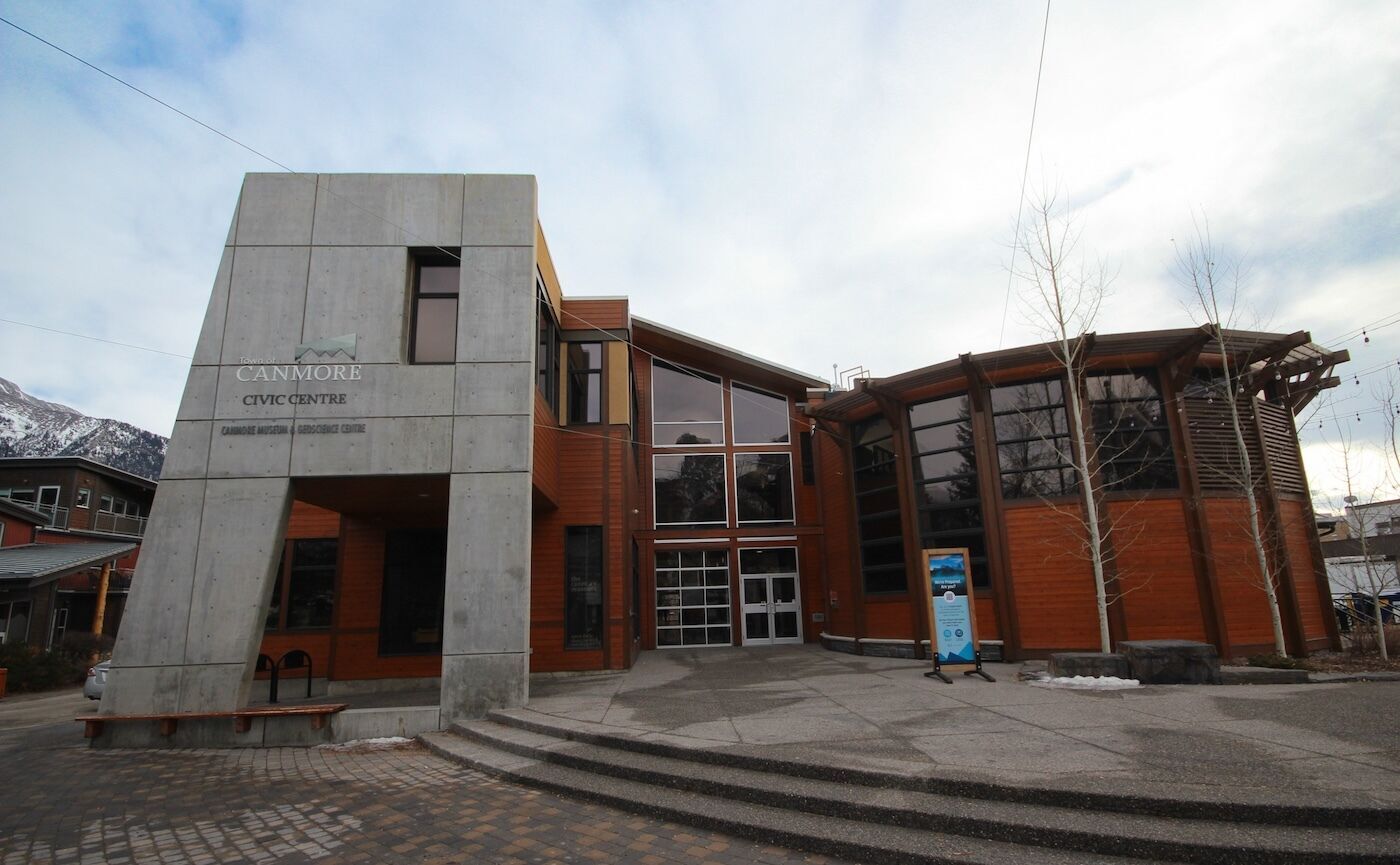
Decision time at Canmore town hall
KLASZUS: In April of 2021, council voted on the Smith Creek plan—the one on the east end of town, across from Dead Man’s Flats. Three Sisters had earlier pitched this to council as a community for locals.
OLLENBERGER: Smith Creek is intended to be a comprehensively planned, primarily residential neighbourhood that will serve Canmore by providing a variety of housing options and commercial spaces to serve the daily needs of the community.
KLASZUS: Here’s town planner Josh Welsh.
JOSH WELSH: Single-family low density makes up 60 to 75% of this proposal.
KLASZUS: Council wasn’t on board with this.
COUNCILLOR McCALLUM: I see a residential footprint that will reflect trophy homes moving into the future. And I don't feel that that is the housing that Canmore needs. That is maybe the housing that people that live outside of Canmore might be interested in. But when I look at this ASP, I'm looking to see how I can fulfill the needs of of our of our present population, and I don't see that that housing would do that.
MAYOR BORROWMAN: I don’t see that low-density housing being that conducive to providing the amount of controlled affordable housing that I believe we need to see with all future development.
COUNCILLOR COMFORT: I won't be able to support this either.
COUNCILLOR JEFFREY HILLSTAD: With the potential urban sprawl, and as Councillor McCallum put it, trophy homes that would be made, I don’t think that that is what our community needs.
KLASZUS: Council voted down the Smith Creek plan unanimously.
I see a residential footprint that will reflect trophy homes moving into the future. And I don’t feel that that is the housing that Canmore needs.
KLASZUS: Next up, in May of 2021, was the decisive vote on the more compact, mixed-use development closer to town. This was the project that council rejected in 2017, the one that proposed building housing on the unfinished golf course.
OLLENBERGER: The Three Sisters Village area structure plan represents a resort application, creating an amenity-rich destination for people to visit, but also a community for residents of Canmore to call home.
The Three Sisters Village ASP has devoted over 40% of the plan area to open space.
KLASZUS: Town admin challenged the notion that this was still a resort application.
WELSH: Currently, the land use bylaw and our municipal development plan stipulate that resort centres, which is what this development intends to be, are intended to be predominantly commercial. And so we view this development as predominantly residential.
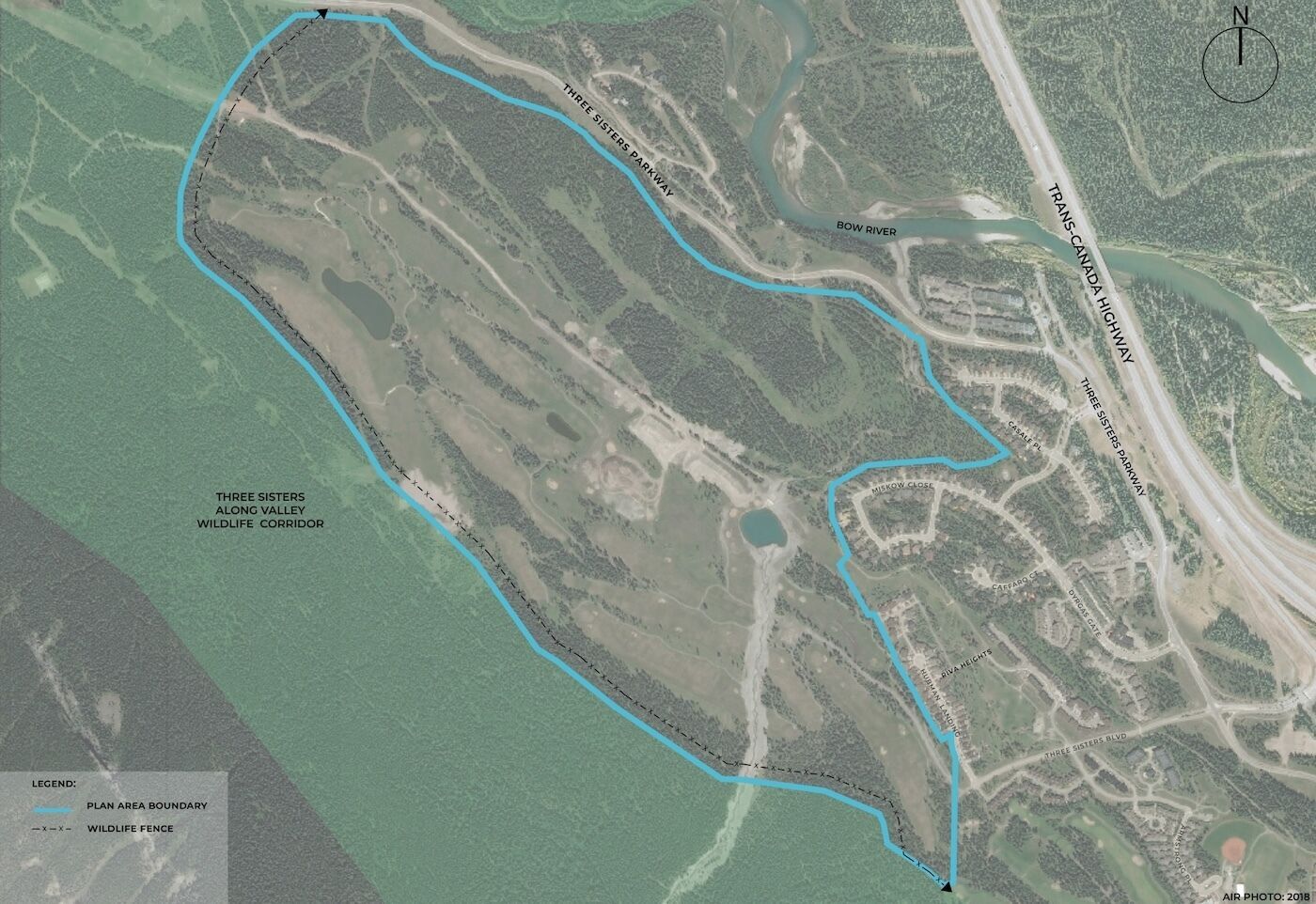
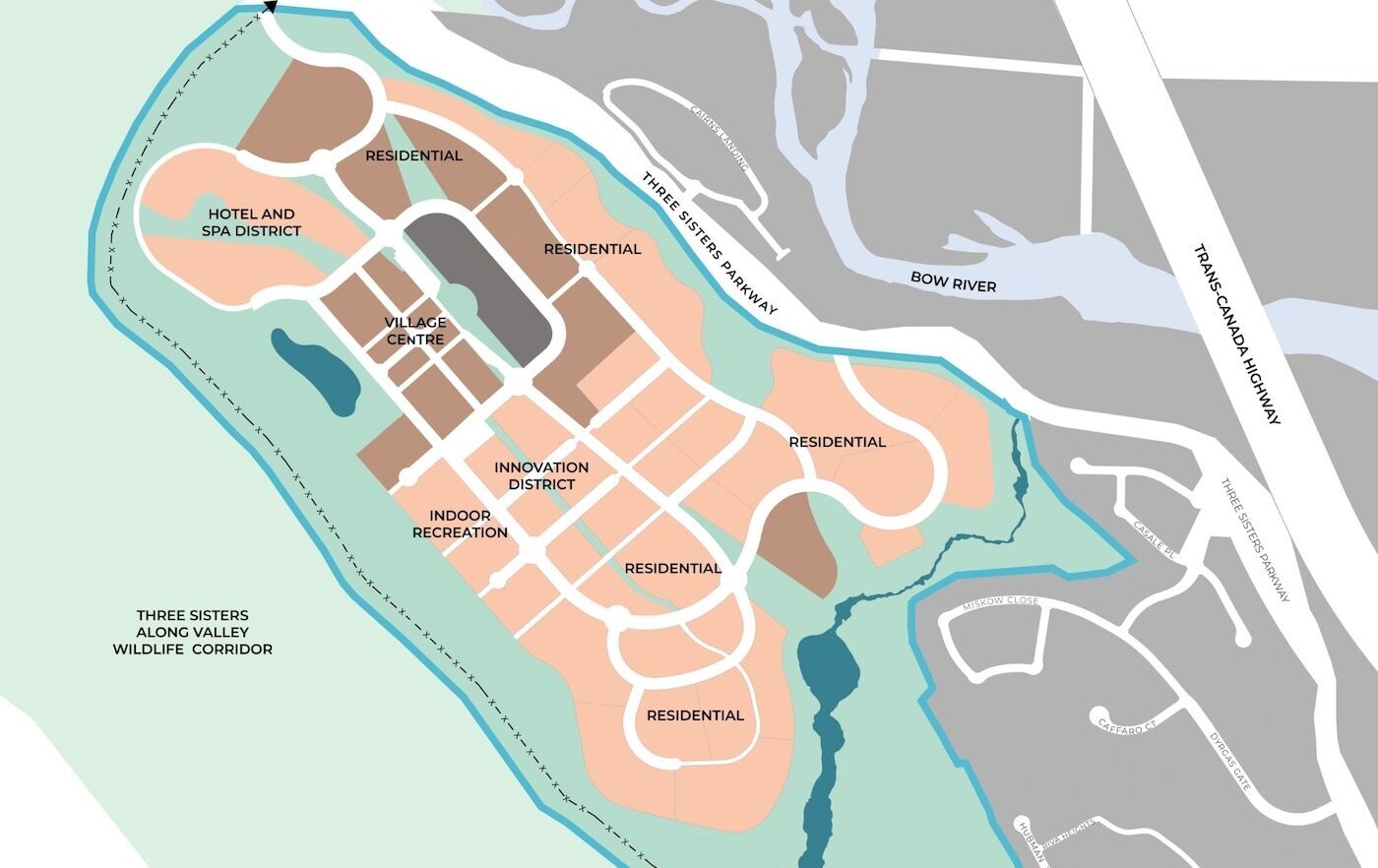
KLASZUS: Council members were more enthusiastic about much of this plan.
COUNCILLOR McCALLUM: I appreciated the proximity of the compact area to existing development, the innovation hub, the hotel and commercial uses mixed with the various types of housing. I appreciate the recreational amenities and I feel that they were very well thought out.
KLASZUS: Even so, council voted this one down too.
COUNCILLOR McCALLUM: I think that there are some very valuable elements in this draft, but I would prefer this draft to show a similar footprint as is seen in the 2004 ASP.
COUNCILLOR KAREN MARRA: Putting this much population up against a very sensitive wildlife corridor is a concern for me. As once said, you can always add more, but you can’t take away.
COUNCILLOR VI SANDFORD: I have very low confidence in the new fencing plan. I think the placement will result in corralling wildlife that is trying to connect to the corridor from the river and the valley bottom.
COUNCILLOR COMFORT: I have to agree with my fellow councillors. I will not be able to support this, and I’m sad about that.
KLASZUS: Only John Borrowman, the mayor at the time, voted in favour.
MAYOR BORROWMAN: I’m disappointed, of course. I saw this as an opportunity to bring some balance to our community.
Putting this much population up against a very sensitive wildlife corridor is a concern for me.
Three Sisters appeals to the property rights tribunal—and 1992
KLASZUS: In the summer of 2021, Three Sisters appealed council’s decisions to the Alberta Land and Property Rights Tribunal, or LPRT. This is a quasi-judicial tribunal tasked with resolving land use planning disputes in Alberta. And the Three Sisters appeal kicked off yet another round of hearings.
The big question the Land and Property Rights Tribunal set out to decide was this: Are the Three Sisters plans consistent with the Natural Resources Conservation Board decision from 1992?
When the NRCB made its decision in 1992, it said it wasn’t seeking to usurp the powers of municipal planning authorities. “The board is satisfied that such an approval would not denude the town of its authority under the Planning Act, nor would it preclude the effectiveness of public participation processes in the town, owing to the need for both the approval of the board and the approval of the town before the project may ultimately proceed,” it said.
But in 1995, the province added Section 619 to the Municipal Government Act. Section 619 prohibited municipalities in Alberta from blocking projects that had already been approved at the provincial level. And this would guide the decision of the Land and Property Rights Tribunal.
ERAN KAPLINSKY: All that the town can do on appeal is to make the case that the proposed development is not consistent with the provincial approval.
KLASZUS: This is Eran Kaplinsky. He’s a University of Alberta law professor who researches property and planning law.
KAPLINSKY: And in this case, the town had a very interesting and powerful argument, and that is that the circumstances have changed dramatically in the decades that passed since the provincial approval was granted.
KLASZUS: The town argued that the NRCB approval was based on social, economic and environmental evidence that was now 30 years old. And so at the hearings, the Town of Canmore...
KAPLINSKY: ...lays out its case and says, here are the changes in terms of the fiscal impact, in terms of the wildlife corridor, the interests of the local Indigenous Peoples, in terms of transportation. And one by one, the tribunal examines these and reaches the conclusion that this proposed project, this proposed area structure plan amendment is consistent with the original approval that was given in 1992.

The town argued that the NRCB approval was based on social, economic and environmental evidence that was now 30 years old.
KLASZUS: The tribunal concluded that both area structure plans were consistent with the 1992 decision. And the tribunal ordered the town to go back and approve the plans.
As a last resort, in 2022, the town then took the matter to the Alberta Court of Appeal.
KAPLINSKY: And in this case, the Court of Appeal said that there wasn't a clear error that justifies intervention.
KLASZUS: The debate at the Land and Property Rights Tribunal got to the heart of this issue—what’s changed since the NRCB approved the project in the early ’90s. A predominantly residential development would never go before the NRCB today.
KAPLINSKY: You have to feel for the town of Canmore, that is now stuck, so to speak, with a project that it doesn’t want, that is potentially transformative, certainly has a very significant impact. And the town says the development is not the development, and the town is no longer the town. But the legal system is concerned with finality, with reliance, with following processes—and not necessarily the substance of the decision.
When the NRCB made its decision in 1992, it said it wasn’t seeking to usurp the powers of municipal planning authorities.
SARAH ELMELIGI: A decision from 1992 could not possibly reflect everything that we have learned since 1992.
KLASZUS: This is Sarah Elmeligi. She’s a conservation biologist and the NDP MLA for the riding of Banff-Kananaskis, which includes Canmore. Elmeligi defeated UCP incumbent Miranda Rosin in the 2023 election.
ELMELIGI: Wildlife corridor science was very nascent in the early 1990s. I mean, we just were at the beginning of trying to understand wildlife corridor connectivity and ecology in that regard. The same with the undermining. We didn’t have the technology to truly understand the scope of the undermining. But we do now. So it is very difficult to be beholden to a decision from 1992 and to pretend like we haven’t learned anything since then.
KAPLINSKY: Local development permits lapse after a certain time, and certainly approvals given by provincial agencies can also have some sort of sunset clauses or exit points or opportunities to be revisited. And in cases such as this, it would be appropriate. But we can’t judge now what the provincial agency had in front of it in 1992.
It is very difficult to be beholden to a decision from 1992 and to pretend like we haven’t learned anything since then.
Three Sisters sues town and council for $161M
KLASZUS: While Three Sisters was waiting for the Land and Property Rights Tribunal to make its decisions, the company took its fight to another level.
In December of 2021, Three Sisters Mountain Village, or TSMV for short, sued the Town of Canmore and individual council members who had voted against the plans for $161 million. Three Sisters alleges they acted “dishonestly, maliciously, and with ill intent” against the developer. The suit argues that council went outside its legal authority, froze development and schemed to keep the lands as essentially a “privately owned public park, maintained at great expense by TSMV, for the use of some of Canmore's residents and visitors.”
The company’s frustration is palpable. Three Sisters says it poured $11 million into developing the two plans in discussion with the town, and that based on its working relationship with town admin and guidance from council, it expected an approval—perhaps with the usual modifications as plans got narrowed down.
In their statement of defence, the town and council members call the suit “an attempt by TSMV to intimidate Canmore and its elected municipal councilors to approve TSMV’s proposed developments.” They argue the town and its council members “retained the ability to influence the scale and scope of development on the Three Sisters land,” and say they were acting in good faith and within their authority.
In its lawsuit, Three Sisters alleges that council members acted “dishonestly, maliciously, and with ill intent” against the developer.
KLASZUS: None of the allegations have been proven in court but the lawsuit has made council members cagey. Not just the ones who are named in the suit, but the ones who were elected after council made those decisions.
COUNCILLOR WADE GRAHAM: It does have an effect. It weighs into your decision making process. It’s not something that I can just ignore.
KLASZUS: This is Councillor Wade Graham. He was elected in October of 2021, just a few months after the previous council had voted down the Three Sisters plans.
COUNCILLOR GRAHAM: There were very few people that were like: We shall never develop up there, ever. It certainly wasn't a position that I took. I know there were a few people that were like that, but not very many. We all knew the development was going to happen up there. It is happening up there right now, and has been happening up there for a long, long time, under an approved ASP. So to me it was about how. And it's still about how.
COUNCILLOR JEFF MAH: It's one of those projects that started and stopped and began and fell apart etcetera.
KLASZUS: Jeff Mah is another first-term councillor. He moved from Calgary to Canmore in 2012 and runs a local yoga studio. And like many people who have moved to Canmore in recent years, he was thrown off when, Three Sisters started presenting its expanded plans around 2015.

COUNCILLOR JEFF MAH: And I think what was being presented at the time, people were really scratching their heads, like, wow. This is something that does not resonate with what I think this community should be. There’s a huge mismatch in values of what’s being proposed with regards to the environment and what the community wants.
KLASZUS: Before they were elected, Mah and Graham helped start Bow Valley Engage, the citizen group opposed to the Three Sisters plans. In the run-up to council’s decisive 2021 votes, they distributed “Stop TSMV” signs and made videos on social media to galvanize opposition.
MAH (FACEBOOK VIDEO): Hey guys, it's me, Jeff Mah from Bow Valley Engage.
GRAHAM: And Wade Graham.
MAH: We’re getting closer to the public hearing for TSMV’s proposal on March 9th. So we thought it would be pretty helpful to give you guys some tips on how to speak at a public hearing.
There’s a huge mismatch in values of what’s being proposed with regards to the environment and what the community wants.
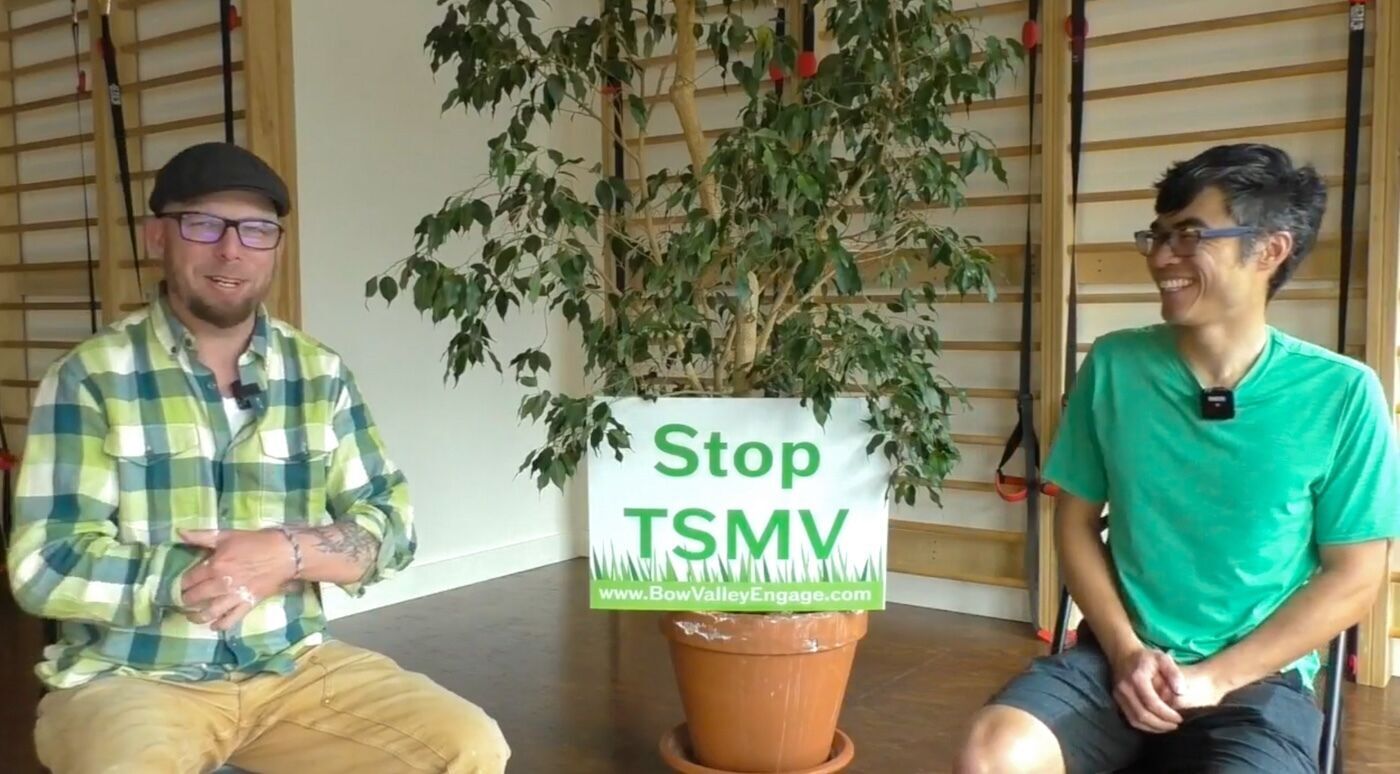
KLASZUS: Less than two months after the new council was elected, Three Sisters filed its lawsuit. The situation was very different than it had seemed earlier in 2021, when Bow Valley Engage was celebrating the defeat of the Three Sisters plans.
COUNCILLOR MAH: It's like The Empire Strikes Back. You know there’s going to be another episode. And so here we are.
The Taylors give $11.5M for bear habitat—at the zoo
KLASZUS: The town of Canmore appeared to be out of options after the Court of Appeal decision came down in October 2023. But some citizens were still pushing back, protesting when Danielle Smith came to town to speak at the Bow Valley Builders and Developers Association monthly luncheon.
PROTESTERS: Not okay! Not okay! Not okay!
MANDY (PROTESTER): This is so wrong. Environmentally, climate change, the sprawl...
KARSTEN HEUER: For Premier Smith—the whole Ottawa versus Alberta meddling line is in her mouth every day. Well, how about how much Alberta is meddling with the future of Canmore, right? It’s huge hypocrisy.
ROBERT JANES: Probably most of the places will be second and third homes for the world’s elite, because Canmore residents won’t be able to afford them.
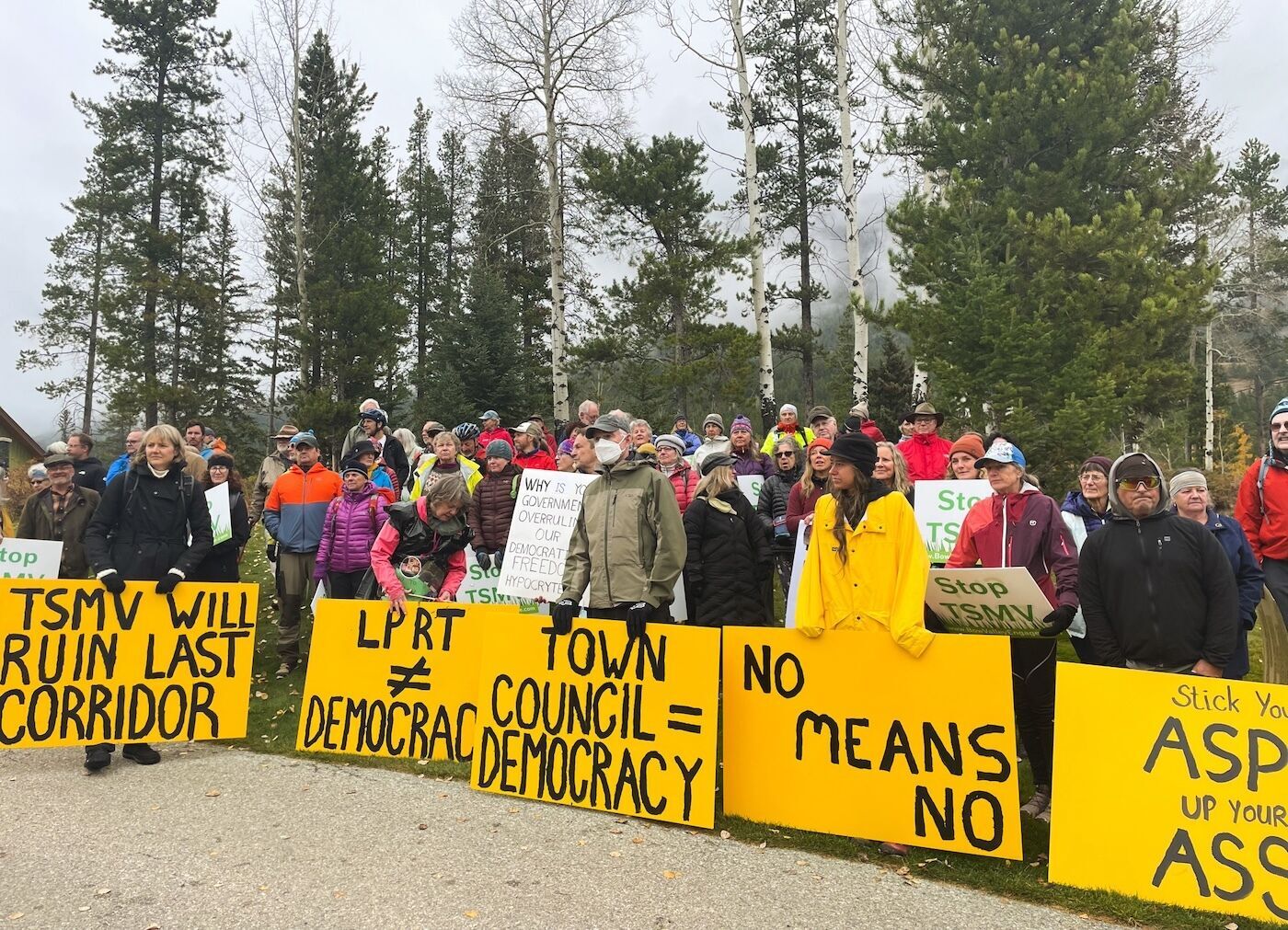
KLASZUS: Meanwhile, earlier in the fall, the Calgary Zoo announced that it had received an $11.5 million donation from the Taylor family for its Canadian Wilds zone—specifically for bear habitat.
HENNA SAEED (CITYNEWS CALGARY): It's the Taylor Family Foundation that has brought back polar bears to the Calgary Zoo after a gap of 24 years. Don Taylor says he fell in love with polar bears on his first trip to the Calgary Zoo 80 years ago.
DON TAYLOR: I can remember there was an iron cage and there was a polar bear in it with a small pool. Obviously, the habitat, the environment, was not conducive to making the polar bear comfortable. What we have here now is an ideal facility for polar bears.
KLASZUS: The Calgary Zoo promotes the new polar bear habitat as having “expansive tree-filled grassy meadows, rock features, several pools... and an unobscured view of the horizon.”

KLASZUS: Canmore residents had plenty to say about this news.
MANDY (PROTESTER): Taylor, the owner of TSMV, just made a transformative $11.5 million dollar gift for the polar bear exhibit at the zoo. So he can spend $11.5 million dollars to help people see captive polar bears in a zoo...
OTHER VOICE: Only two!
MANDY: ...and yet he can’t do anything to protect this iconic Yellowstone to Yukon critical wildlife corridor for grizzly bears.
LISA DOWNING: If they took a chunk of that property and made it into a wildland conservation, it could do worlds of good for hundreds and hundreds of years.
Out of options, town council votes once more
KLASZUS: On October 22nd, about 20 Canmorites brought their grievances to Don Taylor’s doorstep in Calgary. They gathered across the street from his Mount Royal mansion, which has wildlife statues out front—including one of a bear. That’s the protest we heard at the start of this show.
LINDSAY McLAREN: I am very sad and very angry that a decision has been made, that has been forced upon the Bow Valley, that will change it forever. And it was done against the wishes of the communities out there.
SARA RENNER: It doesn’t serve our community, and it doesn’t serve our wildlife. And I think we feel like we’ve been let down by the democratic process.
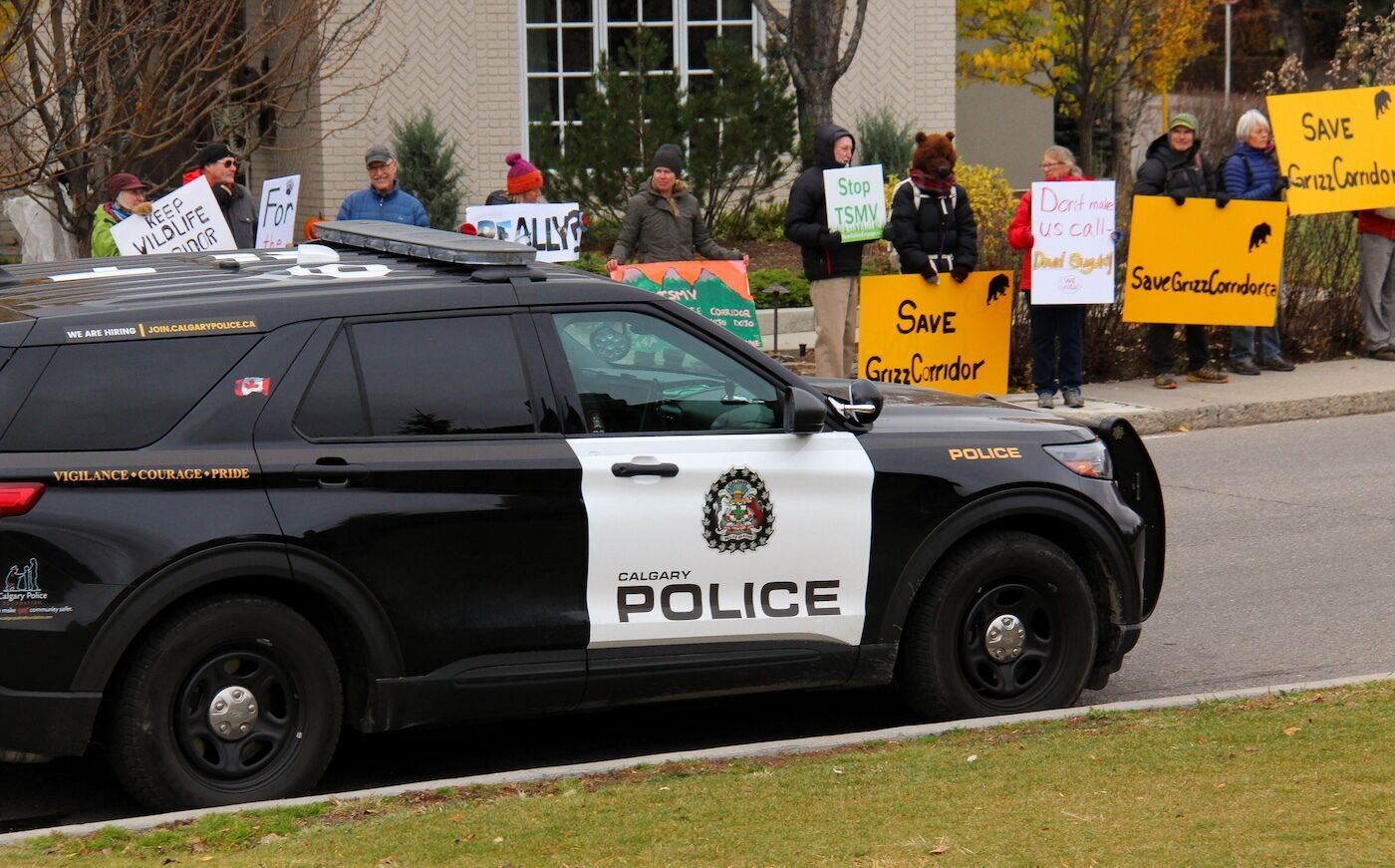
KLASZUS: A couple days later, on October 24, Canmore town council had another pivotal decision to make, based on the rulings of the Land and Property Rights Tribunal and the Court of Appeal. Except it wasn’t really a decision.
MAYOR SEAN KRAUSERT: So here we are today with a court order compelling approval of these ASPs.
KLASZUS: This meeting was brief—and at times emotional. It began with the three councillors who were on the last council, the ones being sued, recusing themselves because of the developer lawsuit against them.
COUNCILLOR JOANNA McCALLUM: The legal action in the Court of King’s Bench in which I am named remains open. I will be abstaining from any discussion of this matter and leaving the room until any discussion and voting are concluded.
COUNCILLOR KAREN MARRA: I too, as previously stated by Councillor McCallum, will be abstaining from any discussions of this matter, and leaving the room.
COUNCILLOR JEFFREY HILLSTAD: I will be echoing the same exact thing.
KLASZUS: That left it to the remaining four council members to vote.
COUNCILLOR WADE GRAHAM: There would be serious consequences for an opposed vote, but I say that if we never had a choice, then why was this document ever even brought before council? Are we just a rubber stamp? If this is not our decision to make, then let those who it is make it.
The province can and should answer to the citizens of this town. By voting against this ASP today, we would send it back to the province, who continually insists on meddling in municipal affairs anyway, just like they claim Ottawa does to them. Yes, we would be charged with contempt of court; possibly spend time in jail. We may be fined. We could even be removed from office.
Yesterday, I learned that even if I alone was to vote against this plan, I could be added to the $161 million lawsuit, and it would be strengthened by my dissension even if the ASP is passed.
If we never had a choice, then why was this document ever even brought before council? Are we just a rubber stamp?

KLASZUS: Councillor Jeff Mah voiced support for his silenced colleagues.
COUNCILLOR JEFF MAH: I feel that council made the right decision. In response, TSMV sued the town and that council personally for $161 million. And this lawsuit continues to hang over each and every one of them, and us as well as Canmorites.
KLASZUS: He also expressed dissatisfaction with the decisions of the Land and Property Rights Tribunal, or LPRT.
COUNCILLOR MAH: A group of appointed individuals with no personal connection to our community’s challenges now held decision making power that surpassed Canmore’s elected representatives.
The public hearing had been silenced. All of the complex issues of our community, the real on the ground day-to-day challenges that we face, were now dismissed under the simplistic, myopic lens of property rights. Affordability, the environment, wildlife connectivity, truth and reconciliation, climate change, social justice, inclusivity—meaningless compared to property rights.
Our provincial government’s framework has failed us. The NRCB decision has failed us. The LPRT has failed us. It’s a dark chapter for Canmore. But I believe this is a long story with much still to be written.
All of the complex issues of our community… were now dismissed under the simplistic, myopic lens of property rights.
KLASZUS: Mayor Sean Krausert said it was time for a new chapter.
MAYOR KRAUSERT: I do have a concern about the process being labeled undemocratic. I may not like it that we don’t get to have discretion on absolutely everything, but those are the rules put in place by the provincial government, and we are created by the provincial government.
KLASZUS: Tanya Foubert, another first-term councillor, also said it was time to move on.
COUNCILLOR TANYA FOUBERT: We are a municipality. We are not an independent city state. I believe that by going to the Court of Appeal, and by pursuing all of our legal, reasonable options, we have taken it as far as we can.
KLASZUS: All four council members voted to approve the plans.
I do have a concern about the process being labeled undemocratic.
After council votes 'yes,' Three Sisters co-owner lashes out
KLASZUS: Some wondered if council’s decision would compel Three Sisters to end its lawsuit and begin mending relationships. They were wrong.
The following week, Three Sisters co-owner Blair Richardson, a former Morgan Stanley executive who started a Denver asset management firm called Bow River Capital, spoke out. Richardson took out a full page ad in the local paper, the Rocky Mountain Outlook with an open letter “to the residence [sic] of Canmore.” He condemned the “immoral” actions of the protesters who had gathered in Calgary and said police “had to attend to ensure the safety of the Taylors.”
As a fact-checking aside: I was there and can tell you that at no point did I see any danger to the Taylors’ safety.
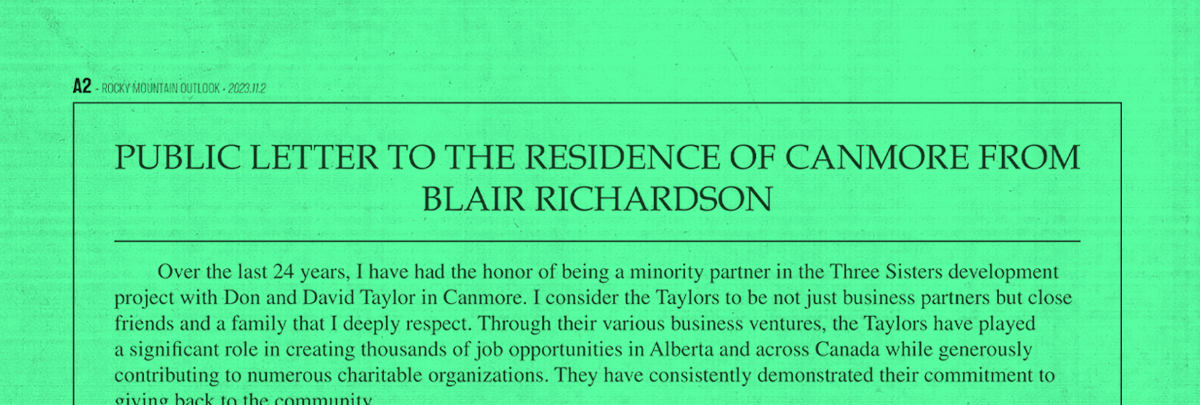
In any case, Richardson had more to say in his open letter.
“It is time for the town’s longstanding efforts to thwart Alberta law to end,” he wrote, and he brandished the threat of the $161-million lawsuit again. “When this matter is resolved,” Richardson wrote, “it could have the potential to severely impact the financial stability of the town and resident’s [sic] tax obligations.”
The letter was long and littered with spelling mistakes and had a Gmail address at the bottom. Many in town were flabbergasted.
COUNCILLOR GRAHAM: It reinforced everything we had been talking about as a community, and in bold letters.
When this matter is resolved, it could have the potential to severely impact the financial stability of the town and resident’s [sic] tax obligations.
KLASZUS: At the next Bow Valley developers luncheon, on November 9, Canmore developer Frank Kernick had some words, and a certain book, for Chris Ollenberger of Three Sisters.
FRANK KERNICK: Chris, I’ve got a book for you that I want you to read and maybe pass on to Blair. It’s Dale Carnegie’s How To Win Friends and Influence People. [crowd erupts in laughter]
KLASZUS: Three Sisters did its best to distance itself from Richardson’s letter, saying it didn’t represent the company view. I asked Ollenberger about this, as it sounded like Richardson was threatening to bleed the town dry—and right after the town had finally given in and approved the plans.
OLLENBERGER: I think some of those things are moments in time versus the longer term process of rebuilding and moving forward. We’ve had people protest at one of our shareholder’s homes here in Calgary. They’re upset. They need a way to express how frustrated and upset they are. I think really, the letter from one of our shareholders should be also put in that light.
It wasn’t so much the intent that he would say we’re still going to bleed you dry, so to speak. I think he was frustrated in that a lot of money and a lot of time and a lot of energy has been focused in the wrong directions, and he really wants it to be much more productive.
It reinforced everything we had been talking about as a community, and in bold letters.
A showdown in the Alberta legislature
KLASZUS: In November, with the decision made, local MLA Sarah Elmeligi raised the Three Sisters issue in the legislature with municipal affairs minister and former Calgary city councillor Ric McIver.
ELMELIGI: In 2021, Canmore residents and businesses participated in one of the longest public hearings in Alberta history. For six days, citizens spoke overwhelmingly against the proposed Three Sisters Mountain Village development. This led the town council at the time to reject it. In response, TSMV Properties took the decision to a UCP-appointed tribunal that ruled in favour of the developer. A provincial body forced the town of Canmore to approve an wanted development. Can the minister please explain to the community of Canmore why the decision made by their elected town council...
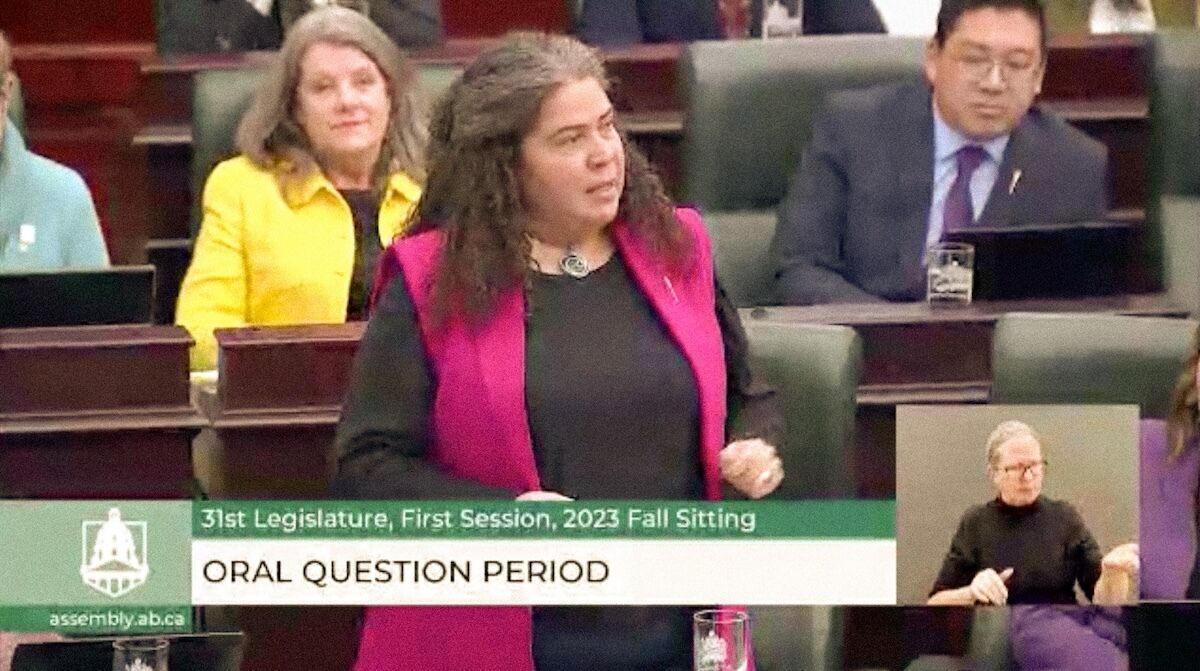
SPEAKER NATHAN COOPER: The honourable the minister of municipal affairs.
MINISTER RIC McIVER: Well thank you, Mr. Speaker. As the honourable member is probably aware, the LPRT made a proper ruling. In fact, the town then took them to court and the town lost. So, Mr. Speaker, the honourable member might have an issue with the judge’s decision, as well as the LPRT decision. But on this side, we respect the rule of law. We respect the decisions of the court. [clamour and cheering]
COOPER: Order! Order! Order! The honourable member is the only one with the call.
ELMELIGI: Well, given that the town of Canmore is in the midst of a significant housing crisis, and businesses struggle to attract or retain workers because of a lack of housing. And given that young people frequently live in their vehicles because they can’t find an affordable place to live. And given that this government has done nothing to build much needed housing. And given that this development also does nothing to address the housing crisis in a meaningful way. Can the minister explain to the residents of Canmore how the province can allow a development like this to proceed when it doesn’t even address the residents’ primary concerns?
COOPER: The honourable the minister of municipal affairs.
MINISTER McIVER: Thank you. Mr. Speaker, I guess the real question is, how can a member of this house stand up and rage about the lack of housing in one question, and right before that, raged against a project that was going to provide thousands of homes? Which is it? [cheers and clamour] Which is it? It can’t be both. Do they want homes, or do they not want homes? They should actually decide because Albertans need to know. On this side, we’re in favour of more homes.
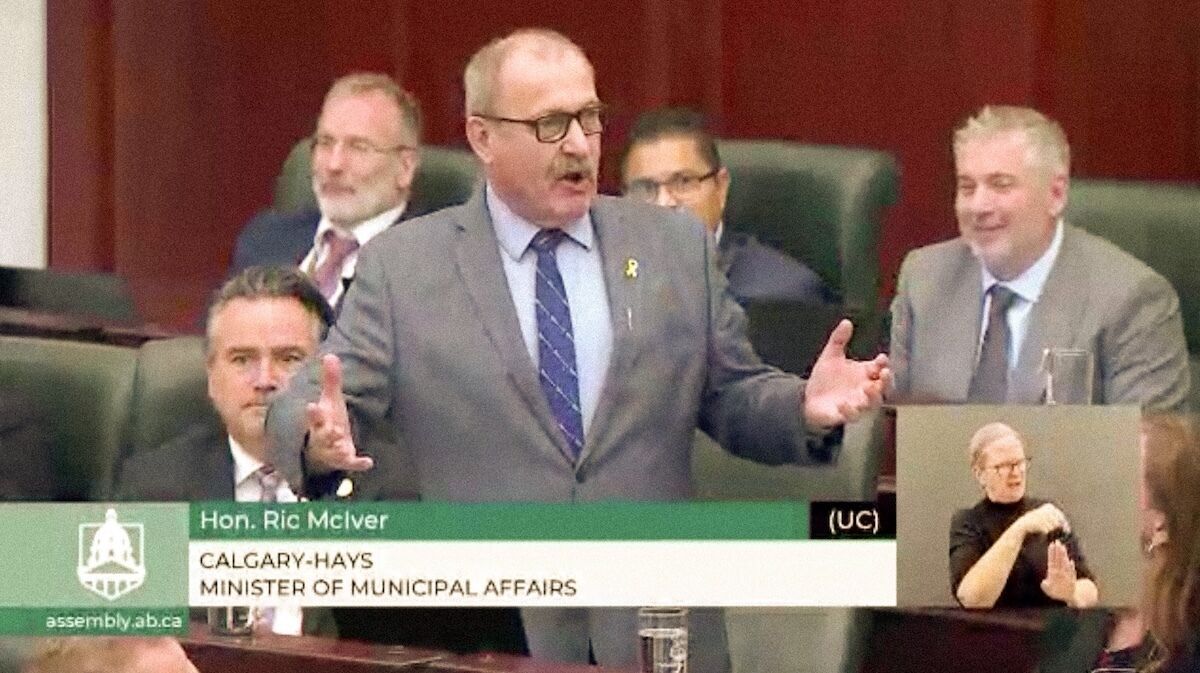
The LPRT made a proper ruling. In fact, the town then took them to court and the town lost.
KLASZUS: The exchange between Elmeligi and McIver raises an important question about the nature of the housing that will be built, and who it’s for.
In 1992, Three Sisters Golf Resorts indicated that it expected about 70% of the units to be for locals who lived in town permanently, and about 30% to be second homes.
Three Sisters Golf Resorts also pledged to build affordable housing. “The most fundamental commitment that I can make is that we will dedicate a significant amount of land to lower-income housing if our project is approved,” Three Sisters co-owner Richard Melchin said at the time.
But what that meant exactly is disputed. The NRCB decision says that in 1992, Three Sisters stated that about half of the project housing would be “relatively low-cost apartments, condominiums, multi-family units and single-family units on lots less than 50 feet.“
We will dedicate a significant amount of land to lower-income housing if our project is approved.
KLASZUS: Here’s what Chris Ollenberger told town council in February 2021.
OLLENBERGER: Both area structure plans have policies that require 10% of multi-residential units contain affordable housing units.
KLASZUS: It’s fairly common for developers’ generous promises of affordable housing to fade into something much less ambitious. But Ollenberger says that’s not the case here.
OLLENBERGER: So what is actually in the NRCB decision is relatively lower cost forms of housing. So it didn't actually say: here are the price points. It talked about having smaller homes, multifamily homes. Because obviously, the difference between a single-family house and a multifamily apartment building is significant. The cost of the land is shared, the cost of the infrastructure is shared, things like that. But the word forms was lost in a lot of conversations that occurred within Canmore. And so people would pick up the torch, forget the word forms and say, well, they promised us 50% affordable housing, and now it's down to 10%—when it's actually a very apples to oranges comparison.
KLASZUS: The Land and Property Rights Tribunal said “it is clear that the NRCB did not intend for the project to provide 50% to 60% affordable housing in accordance with current perceptions to mean providing below-market housing.” The tribunal added that it expected more supply to “ease pressure on housing prices.”
It’s fairly common for developers’ generous promises of affordable housing to fade into something much less ambitious.
OLLENBERGER: There really truly is a housing crisis throughout Canada, in Alberta, and I would acutely, within Canmore. We’ve lost a number of years of actually adding to supply. There are a number of factors that are part of the housing process within Canada, and they all have nuances depending on location. But in Canmore particularly, because there’s such a limited footprint, if there’s no supply, if there’s no housing being built—well, guess what happens to demand?
The reality is that Canmore is on the footsteps of Banff National Park and there’re a high number of people that say, I’d love to live there and drive back to Calgary two to three days a week for meetings, and then still live in Canmore. You can see a lot of people doing that on the highway even today.
So I think having that clarity of the court decision and the LPRT, I think has been a reset moment for both the town and Three Sisters of the rules of engagement are known, and let’s just focused on what we’re supposed to be focused on at this point.
KLASZUS: When it comes to how much affordable housing will actually be built, Alberta municipalities are limited by the province’s Municipal Government Act.
MAYOR KRAUSERT: We don't have the ability to enforce affordable housing. So all we can do is encourage and basically take what we get.
Because there’s such a limited footprint, if there’s no supply, if there’s no housing being built — well, guess what happens to demand?
Stoney Nakoda sue town and province to block developments
KLASZUS: This saga still wasn't over. December of 2023 brought more news.
TARA NELSON (CTV CALGARY): A controversial development on the eastern edge of Canmore faces renewed opposition. This time from the Stoney Nakoda First Nation.
KLASZUS: The Stoney Nakoda Nations, or Îyârhe Nakoda, were suing the Town of Canmore and the province of Alberta for approving the plans. The Stoney Nakoda say the Three Sisters plans will further encroach onto their traditional territory, stress an already fragile environment, and further fragment wildlife habitat.
They also bring up the issue of what has changed since 1992. Specifically, the constitutional requirement to consult Indigenous groups on projects was not judicially established until after that.
William Snow is the consultation manager for the Stoney Nakoda Nations, comprised of the Chiniki, Bearspaw and Goodstoney Nations. Snow declined to be interviewed for this story but spoke at the 2021 public hearing about the Nations’ concerns.
WILLIAM SNOW: Culturally important species like grizzly bears have an important role in Stoney society. Most wildlife studies approach an understanding of wildlife from the Western science perspective, while little is written or understood about wildlife from the Traditional Knowledge perspective.
The studies for Three Sisters, to date, do not include that Traditional Knowledge perspective. Because this perspective has not been understood or taken seriously, we’re running the risk of constructing or operating a development that is culturally inadequate, inappropriate, or both.
The bylaw for the Three Sisters and Smith Creek applications should be denied. Consultation with Stoney Nakoda should be done properly and meaningfully.
The studies for Three Sisters, to date, do not include that Traditional Knowledge perspective.
The takeaways—and what's next
KLASZUS: A lot has changed since Canmore was established as a coal mining outpost in the 1880s.
JOSH WELSH: But the reality that we have today is we’ve really replaced one extractive industry—coal—with another: housing and tourism. And some could argue that the latter is more intractable, because once you build the roads, once you bring the people, once you build the houses, you can’t really take them away.
KLASZUS: Here’s local publisher Kristy Davison, who started the independent website Canmore Commons to document development in the Bow Valley.
KRISTY DAVISON: We have turned down much smaller footprints than this. The biggest one ever just got fully approved. That is devastating. They got so much.
KLASZUS: Which brings us back to that unfinished golf course.
DAVISON: That to me the the symbol of everything that went wrong with this. Because people fought tooth and nail to get that golf course be a buffer zone. The town was willing to say, okay, you can develop this, this, this and this—but you have to leave this. We fought so hard for that, and this plan erases that entire fight. There’s going to be nothing left for the animals in that space. Done. Like, that hurts.
We’ve really replaced one extractive industry — coal — with another: housing and tourism.
ELMELIGI: I think that the whole TSMV development, from the very beginning, is an example of provincial overreach that the town has never truly been able to accept at face value, and has constantly been trying to work on to create something that they can live with. And now we’re where we are, and it’s very frustrating for a lot of people.
OLLENBERGER: Maybe in hindsight, this crisis moment should have come sooner. It might have led to some angst being lowered in the town to this point now. Because I think unfortunately, a lot of people for a number of years had assumed that the town could always just say no whenever they wanted to. And that led to this tension that would just keep going back and forth where Three Sisters would say, we have this provincial approval, and there’d be people in the town saying, yeah, but we can still say no.
So the focus I think will shift, and I think relatively quickly, from instead of talking about if the project should go forward, which was a mistake for many years to have that as the focal point, to how does the project move forward, and what does it look like within the boundaries of the developed area now that the wildlife corridors are set?
We have turned down much smaller footprints than this. The biggest one ever just got fully approved. That is devastating.
HILARY YOUNG: I really don't think this is over. I don't think it's a done deal.
KLASZUS: This is Hilary Young, the Yellowstone to Yukon conservation director.
YOUNG: I know the community is mobilizing. And there are hundreds of residents and visitors who really care about this issue who have not let it go yet.
I would love to see the development itself shrunk. And for some of the land that is encroaching into that wildlife corridor to be given back to the town or given to the province or somehow not developed.
KLASZUS: The Stoney Nakoda Nations and Bow Valley Engage are calling on the province to do a new environmental assessment for the two developments. Whatever happens from here on out, Three Sisters Mountain Village, or TSMV, has made a mark on not only the town’s geography, but also its culture.
COUNCILLOR GRAHAM: I think it’s really interesting to see what has come of this saga. I went to an open mic night the other night, just a local artsPlace community open mic night, and somebody started singing a protest song about TSMV. I was really kind of taken aback about it.
[music plays]
PROTEST SONG BY TRACEY HENDERSON:
You act like bullies in the schoolyard
And hide behind your philanthropy
Actions speak louder than words
Don’t you care about community?
The courts affirmed your property rights
But what you’re doing, it’s all wrong
Your money will all be in the bank
By the time the bears are all gone
And it ain’t right, and we’re not gonna take it
You can take your lawsuits and shove ‘em up your—
Ask yourself
What'll you tell your grandkids
When they say, hey gramps, where’d all the grizzly bears go?
When they say, hey gramps, where’d all the grizzly bears go?
Jeremy Klaszus is editor-in-chief of The Sprawl. He can be reached at hello@sprawlcalgary.com. If you appreciated this story, please support The Sprawl's independent journalism today!
One more thing—support independent journalism!
Sign Me Up!The Sprawl connects Calgarians with their city through in-depth, curiosity-driven journalism. But we can't do it alone. If you value our work, support The Sprawl so we can keep digging into municipal issues in Calgary!





